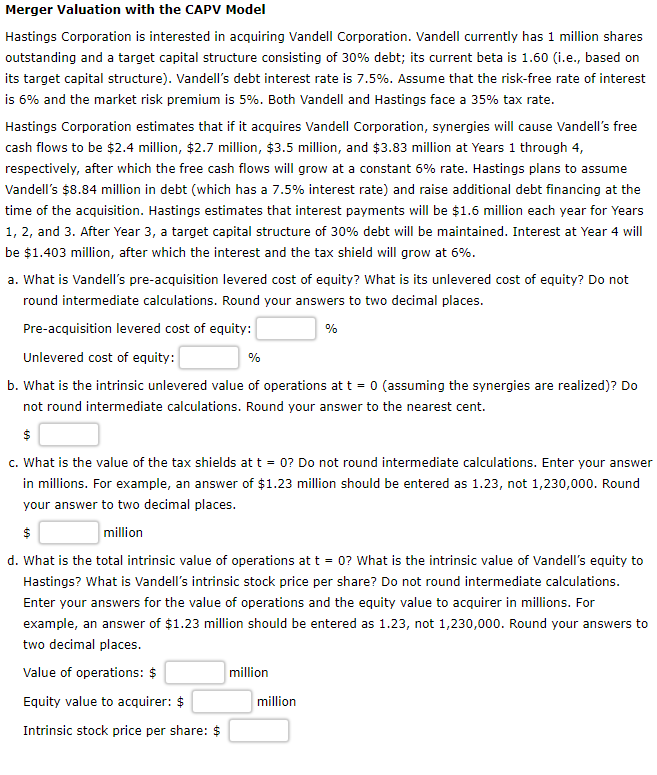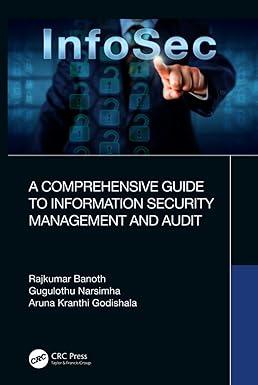
Merger Valuation with the CAPV Model Hastings Corporation is interested in acquiring Vandell Corporation. Vandell currently has 1 million shares outstanding and a target capital structure consisting of 30% debt; its current beta is 1.60 (i.e., based on its target capital structure). Vandell's debt interest rate is 7.5%. Assume that the risk-free rate of interest is 6% and the market risk premium is 5%. Both Vandell and Hastings face a 35% tax rate. Hastings Corporation estimates that if it acquires Vandell Corporation, synergies will cause Vandell's free cash flows to be $2.4 million, $2.7 million, $3.5 million, and $3.83 million at Years 1 through 4, respectively, after which the free cash flows will grow at a constant 6% rate. Hastings plans to assume Vandell's $8.84 million in debt (which has a 7.5% interest rate) and raise additional debt financing at the time of the acquisition. Hastings estimates that interest payments will be $1.6 million each year for Years 1, 2, and 3. After Year 3, a target capital structure of 30% debt will be maintained. Interest at Year 4 will be $1.403 million, after which the interest and the tax shield will grow at 6%. a. What is Vandell's pre-acquisition levered cost of equity? What is its unlevered cost of equity? Do not round intermediate calculations. Round your answers to two decimal places. Pre-acquisition levered cost of equity: Unlevered cost of equity: b. What is the intrinsic unlevered value of operations at t = 0 (assuming the synergies are realized)? Do not round intermediate calculations. Round your answer to the nearest cent. c. What is the value of the tax shields at t = 0? Do not round intermediate calculations. Enter your answer in millions. For example, an answer of $1.23 million should be entered as 1.23, not 1,230,000. Round your answer to two decimal places. million d. What is the total intrinsic value of operations at t = 0? What is the intrinsic value of Vandell's equity to Hastings? What is Vandell's intrinsic stock price per share? Do not round intermediate calculations. Enter your answers for the value of operations and the equity value to acquirer in millions. For example, an answer of $1.23 million should be entered as 1.23, not 1,230,000. Round your answers to two decimal places. Value of operations: $ million Equity value to acquirer: $ million Intrinsic stock price per share: $ Merger Valuation with the CAPV Model Hastings Corporation is interested in acquiring Vandell Corporation. Vandell currently has 1 million shares outstanding and a target capital structure consisting of 30% debt; its current beta is 1.60 (i.e., based on its target capital structure). Vandell's debt interest rate is 7.5%. Assume that the risk-free rate of interest is 6% and the market risk premium is 5%. Both Vandell and Hastings face a 35% tax rate. Hastings Corporation estimates that if it acquires Vandell Corporation, synergies will cause Vandell's free cash flows to be $2.4 million, $2.7 million, $3.5 million, and $3.83 million at Years 1 through 4, respectively, after which the free cash flows will grow at a constant 6% rate. Hastings plans to assume Vandell's $8.84 million in debt (which has a 7.5% interest rate) and raise additional debt financing at the time of the acquisition. Hastings estimates that interest payments will be $1.6 million each year for Years 1, 2, and 3. After Year 3, a target capital structure of 30% debt will be maintained. Interest at Year 4 will be $1.403 million, after which the interest and the tax shield will grow at 6%. a. What is Vandell's pre-acquisition levered cost of equity? What is its unlevered cost of equity? Do not round intermediate calculations. Round your answers to two decimal places. Pre-acquisition levered cost of equity: Unlevered cost of equity: b. What is the intrinsic unlevered value of operations at t = 0 (assuming the synergies are realized)? Do not round intermediate calculations. Round your answer to the nearest cent. c. What is the value of the tax shields at t = 0? Do not round intermediate calculations. Enter your answer in millions. For example, an answer of $1.23 million should be entered as 1.23, not 1,230,000. Round your answer to two decimal places. million d. What is the total intrinsic value of operations at t = 0? What is the intrinsic value of Vandell's equity to Hastings? What is Vandell's intrinsic stock price per share? Do not round intermediate calculations. Enter your answers for the value of operations and the equity value to acquirer in millions. For example, an answer of $1.23 million should be entered as 1.23, not 1,230,000. Round your answers to two decimal places. Value of operations: $ million Equity value to acquirer: $ million Intrinsic stock price per share: $







